Threads, mirrors and tiles
Shahid Mirza
Courtesy: The Friday Times, Lahore
Degree show by the students of MA (Hons.) visual arts program at National College of Arts, Lahore. 11_17th December 2006.
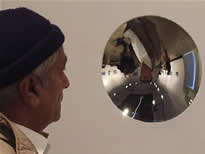 Compulsion, intuition or impulses are no more the guiding principles of art practice. Interrogating appearances, investigating aesthetics and breaking up the accepted notions of art and craft are the centerpiece of contemporary art study. The visual artist materialize his dissatisfaction with the social order and longing for preservation of living culture in the invention and arrangement of spaces, surfaces, shapes and colors of his visual constructions. Craft and folk aesthetics once considered low or no art are at present accredited as the starting point of all creative human acts; art in essence is an elevated craft. Compulsion, intuition or impulses are no more the guiding principles of art practice. Interrogating appearances, investigating aesthetics and breaking up the accepted notions of art and craft are the centerpiece of contemporary art study. The visual artist materialize his dissatisfaction with the social order and longing for preservation of living culture in the invention and arrangement of spaces, surfaces, shapes and colors of his visual constructions. Craft and folk aesthetics once considered low or no art are at present accredited as the starting point of all creative human acts; art in essence is an elevated craft.
An essential component of the two years MA (Hons.) degree program at NCA is six weeks apprenticeship with a local traditional craftsperson, the aim is to initiate students to at least one traditional craft, its social context and issues of practice. Inspired both visually and theoretically by the skills and ideas learned from this interaction, the consequential practice is emulated in the final presentation of all three students.
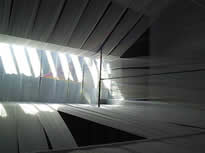 Fatima Khalid attended a traditional Zardozi (silk, silver and gold thread embroidery) workshop; the work is mostly done by women who work together within confines of there homes and the produce is typically managed by the male members of the family. Fatima’s work developed from small structures made with translucent butter paper or transparent plastic bottles that acted as the boundaries within which the colorful threads are found. The small objects present a visual contrast, built from varying shapes, materials, textures and colors, the exterior surface is exact, dull and without colors while the interior is fluid, decorated and colorful. Fatima Khalid attended a traditional Zardozi (silk, silver and gold thread embroidery) workshop; the work is mostly done by women who work together within confines of there homes and the produce is typically managed by the male members of the family. Fatima’s work developed from small structures made with translucent butter paper or transparent plastic bottles that acted as the boundaries within which the colorful threads are found. The small objects present a visual contrast, built from varying shapes, materials, textures and colors, the exterior surface is exact, dull and without colors while the interior is fluid, decorated and colorful.
 The theme grows further in her final installation where she treats the physical space outside and within the house as male and female domains and elaborates through juxtaposing forms, textures and colors. The walls of the cubical colonial display space are covered with long panels of white cotton cloth; it defines the boundaries within which the drama of women exploitation and invention is staged. The sparse presence of hung colorful shapes made with silk threads fail to change the character of the dreary room, this symbolizes the given. In the middle of the room the possible unfurls, a new space is build with hanging cloth panels, the scenario changes radically as one enters from unpitying outside to the clement within. A suspended conical structure built with colorful silk threads on circular shapes reminiscent of round frames used in embroidery is found ascending to the skylight, which illuminates the vertical panels, circular shapes and silk threads. The ingeniously maneuvered space within the outer shell offers an alternative appraisal of physical spaces, gender roles and conceptual concerns for the production. The theme grows further in her final installation where she treats the physical space outside and within the house as male and female domains and elaborates through juxtaposing forms, textures and colors. The walls of the cubical colonial display space are covered with long panels of white cotton cloth; it defines the boundaries within which the drama of women exploitation and invention is staged. The sparse presence of hung colorful shapes made with silk threads fail to change the character of the dreary room, this symbolizes the given. In the middle of the room the possible unfurls, a new space is build with hanging cloth panels, the scenario changes radically as one enters from unpitying outside to the clement within. A suspended conical structure built with colorful silk threads on circular shapes reminiscent of round frames used in embroidery is found ascending to the skylight, which illuminates the vertical panels, circular shapes and silk threads. The ingeniously maneuvered space within the outer shell offers an alternative appraisal of physical spaces, gender roles and conceptual concerns for the production.
Mohammad Junaid learnt traditional crafts of Sheeshakari, decoration with mirrors and Chitrae, decorative metal craft; he was enthralled and provoked by the use of mirrors and polished surfaces in traditional decorations. Interestingly the images formed on the reflective surface of a thumb pin triggered his imagination and gave direction to his artistic quest, he did dozens of pencil drawings and the experience led him to explore various forms of polished surfaces and making of illusion.
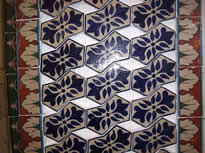 The distortions created by mirrors, both concave and convex and the resulting ambiguity are the subject of his photographs which scantily decorate the gallery walls. The edge of the convex lens that in nature would separate the sky and the earth becomes horizon line in his landscape pictures, unfurling an imaginative mix of confined spaces and open vistas, suspended and split, yet unified. The distortions created by mirrors, both concave and convex and the resulting ambiguity are the subject of his photographs which scantily decorate the gallery walls. The edge of the convex lens that in nature would separate the sky and the earth becomes horizon line in his landscape pictures, unfurling an imaginative mix of confined spaces and open vistas, suspended and split, yet unified.
In Junaid’s final presentation, the recurrent themes are the vulnerability of sense perception, physical space and its transformation in reflection. His interactive installation questions the notion of reality, form, space and time. From a distance, you see yourself upside down in a reflective concave mirror but as you move closer, the image changes to right side up, the reflections are projected live on the gallery wall. Almost all who entered the display area were found playing with the imaginative device. The materializing of challenges and complex ideas in his work illustrate the very essence of art practice that is to experience, convert and share.
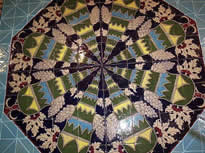 Ghulam Hyder belongs to a traditional family of Kashigars (makers of glazed tiles with colorful intricate designs) of Nasarpur, Sindh. His family runs one of the two remaining Kilns in the historic centre that suffered greatly from neglect and lacks of patronage. Ghulam Hyder belongs to a traditional family of Kashigars (makers of glazed tiles with colorful intricate designs) of Nasarpur, Sindh. His family runs one of the two remaining Kilns in the historic centre that suffered greatly from neglect and lacks of patronage.
The colors and the quality of glazes remains the biggest challenge in making of glazed tiles and is a major obstacle in restoration and conservation of the historical buildings, which are, characterized more with variety and richness of decoration than structural elements.
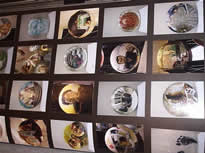 In his final presentation, Ghulam made his own tiles, experimented with the traditional decorative motifs, and produced a range of functional and aesthetic creations. A square tabletop made with glazed tiles is the showpiece of his display. Representing a garden, the geometric design exploits the conventional elements like repetition, symmetry and continuous generation of pattern. The motifs of the cypress tree and grape vines gracefully translate into ornamentations; light blue tiles denoting water from the courtyard pool surround the circular arrangement. In his final presentation, Ghulam made his own tiles, experimented with the traditional decorative motifs, and produced a range of functional and aesthetic creations. A square tabletop made with glazed tiles is the showpiece of his display. Representing a garden, the geometric design exploits the conventional elements like repetition, symmetry and continuous generation of pattern. The motifs of the cypress tree and grape vines gracefully translate into ornamentations; light blue tiles denoting water from the courtyard pool surround the circular arrangement.
Glazed tiles of various size and designs are used to change a window of the display area into a traditional arch; visible through the window is an undersized fountain outside made with the same material. For surface decoration of the arch, he uses arabesque, employing vine and plant motifs and infinitely expandable symmetrical designs that confer the sense of rhythm and the spirit of geometry on his design.
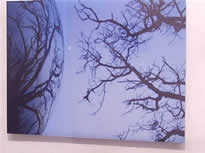 In conventional treatment, the building surface is wholly covered with tiles and the negative and positive spaces are created with different colors, Ghulam has used the original surface of the building as a negative space and used tiles to construct positive areas. Ghulam Hyder is well versed in traditional tile making and surface decoration and his efforts to learn and practice the ancient art are praiseworthy, but his design skills lack complexity and sophistication. Technically speaking, the quality of glazes and use of color tone is much below the established standards. In conventional treatment, the building surface is wholly covered with tiles and the negative and positive spaces are created with different colors, Ghulam has used the original surface of the building as a negative space and used tiles to construct positive areas. Ghulam Hyder is well versed in traditional tile making and surface decoration and his efforts to learn and practice the ancient art are praiseworthy, but his design skills lack complexity and sophistication. Technically speaking, the quality of glazes and use of color tone is much below the established standards.
“Taste as distinguished from understanding consists of confused perceptions for which one cannot give an adequate reason. It is something like an instinct,” wrote seventeenth century rationalist philosopher Wilhelm Leibniz, “Tastes are formed by nature and by habits. To have good taste, one must practice enjoying the good things which reason and experience have already authorized.” |
![]()


![]()